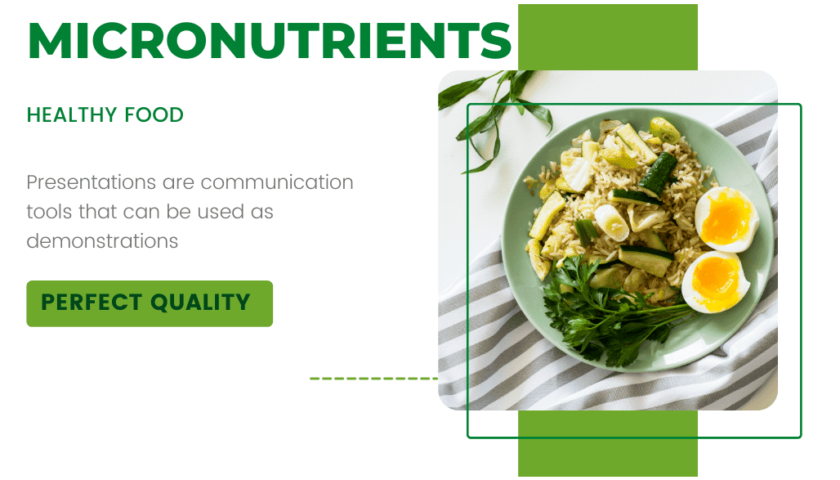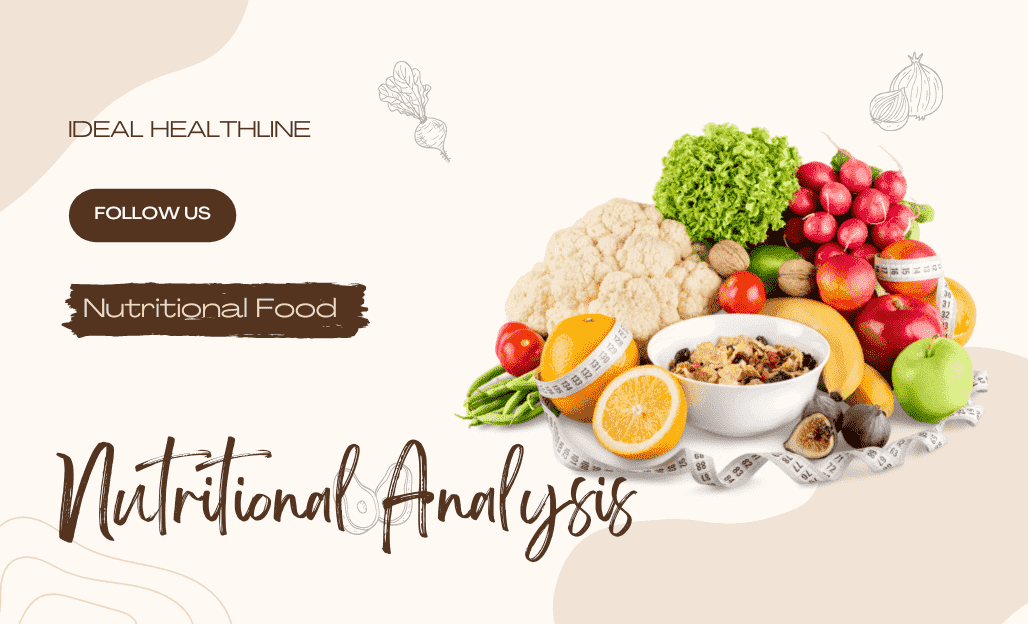Nutritional Analysis” is a term that refers to the process of scientifically evaluating the nutritional content of food. It involves determining the nutrient content of food, including calories, fat, protein, carbohydrates, vitamins, minerals, and other components. This article will discuss the importance of nutritional analysis and how it can be used to improve our diets and health.
Nutrition is one of the most important aspects of our lives, and it’s something that we should be paying close attention to. Too often, we rely on what we hear from others without doing our own research. In this blog post, we will provide you with nutritional analysis for a few common foods so that you can get a better understanding of what’s really in them. We hope this information will help you make healthier choices and live longer.
OVERVIEW OF NUTRITIONAL ANALYSIS:
Proteins, carbs, and lipids help compensate our bodies. Proteins comprise the largest part of our diet, about 60-70% of our daily caloric intake (1). Carbohydrates account for about 10-15% of our daily caloric intake and are broken down into simple sugars like glucose and fructose, which are then used as energy by the body (2). Fat makes up around 20-25% of our daily caloric intake and is essential for maintaining healthy skin, hair, and nails (3).
There are various ways to measure a person’s nutritional status. One common way is calculating a person’s body mass index (BMI). BMI is a measure of weight about the height that can be used to determine if a person is overweight or obese. The Centers for Disease Control and Prevention (CDC) defines obesity as a BMI above 30 kg/m2 (4). A BMI below 18.5 kg/m2 is considered normal weight, while a BMI between 18.5-24.9 kg/m2 is considered overweight, 25-29.9 kg/m2 is considered obese, and 30kg/m2 or more is considered morbidly obese (4).
Another way to measure nutritional status is by analyzing blood cholesterol levels. LDL (“bad”) cholesterol levels are usually above 130 mg/dL, while HDL (“good”) cholesterol levels are usually above 50 mg/dL (5).
BENEFITS OF NUTRITIONAL ANALYSIS:
When it comes to understanding the nutritional content of foods, there are various analytical methods to choose from. Each has its own set of advantages and disadvantages, so it’s critical to know what you’re looking for before making a selection.
Nutritional analysis can help you learn about the nutrients in your food and how they affect your health. It can also help you track how your diet affects your physique and mood. There are many different types of nutritional analyses, but all of them use some form of measurement to determine the nutrient content of a food.
One type of nutritional analysis is called bioavailability testing. This technique is used to assess the ability of nutrients in food to be absorbed by the body. Bioavailability testing can determine the effectiveness of supplements, identify potential problems with nutrient absorption, and evaluate the nutrient composition of foods.
Another type of nutritional analysis is called chemoinformatics. This approach uses computers to analyze chemical data from foods to identify their constituents and nutritional value. Chemoinformatics helps researchers develop new dietary guidelines and improve food labeling laws.
Many different types of nutritional analyses can be used for different purposes. It’s important to choose an analysis method that will meet your needs and expectations before starting any research into dietary habits or health concerns.
Improving Dietary Habits:
Countless online tools allow consumers to analyze the nutritional content of foods. People need to know what they eat to make informed choices and improve their diet quality.
Nutritional analysis can help people understand the amounts of vitamins, minerals, and other nutrients they are consuming in each meal. Nutritional labels on food packaging can also provide information about the nutrient profile of a product.
Food labels can provide quantitative information about a food’s calories, Protein, carbohydrate, fat, and fiber content. They can also list the proportions of each macronutrient in a product. Food manufacturers may also add synthetic or artificial ingredients to products deemed unhealthy by health experts. Knowing the nutritional content of a particular product is an important way for consumers to make informed choices about their diet.
Balanced Diet:
Science has long known that a balanced diet is key to good health. To ensure you get all the nutrients your body needs, it’s important to know what specific foods provide them. In this article, we will look at the nutritional content of some popular foods and see which ones might be best for a balanced diet.
We’ll begin by looking at carbohydrates. Carbohydrates are essential for energy production and play an important role in maintaining blood sugar levels and regulating digestion. Some common sources of carbohydrates include bread, pasta, cereal, rice, potatoes, and fruit.
It’s vital to recognize that not all carbohydrates are created equal. Complex carbs (like those found in whole grains) provide more fiber and other nutrients than simple carbs (like those in sugars). When choosing carbs for your diet, it’s worthwhile to consider the glycemic index—a measure of how quickly a particular carb will raise blood sugar levels. Low-glycemic index carbs are typically better choices for people with diabetes or other conditions that can affect blood sugar regulation.
Now let’s take a look at fats. Fats are essential for energy production and help keep us warm during cold weather months. They’re also necessary for healthy skin and hair and proper cholesterol levels. Some common fat sources include oils, nuts, seeds, avocados, cheese, and meats.
Portion Control:
It’s easy to see how portion control can help you lose weight, but what is actually in those portions? Nutritional analysis can help unveil the facts of life and help you make better choices about what to eat. In this post, we’ll look at three common types of nutritional analysis and how they can help you slim down.
First up is the macronutrient breakdown. This analysis tells you which nutrients are in your food and how much each contributes. It also tells you how many calories are in each serving. This information can be helpful when trying to figure out how many calories to consume per day. For example, if you know that the macronutrient breakdown for a particular food contains 30% protein, 20% carbs, and 50% fat, then it’s safe to say that each serving will contain around 300 calories.
Next up is the micronutrient breakdown. This analysis tells you which vitamins and minerals are in your food and how much each contributes. It also tells you how many milligrams (mg) of a particular nutrient are in each serving. This information can be helpful when trying to figure out whether or not a specific food contains enough of a particular nutrient. For example, if you know that the macronutrient breakdown for a particular food contains 30% protein, 20% carbs, and 50% fat, then it’s safe to say that each serving.
UNDERSTANDING THE NUTRITIONAL FACTS OF LIFE:
Many aspects of life can be analyzed and understood through nutritional facts. This article will focus on some key areas of nutrition, such as the number of calories in food and how this affects your weight, carbohydrates, Protein, and more.
Calories are the most common form of energy your body uses to function. The number of calories in a food is determined by its total carbohydrate, Protein, and fat content. For example, one cup of cooked white rice has 123 calories and 4 grams of carbs. However, one cup of cooked brown rice also has 4 grams of carbs but also includes 3 grams of fiber which adds up to about 10% of the daily value for fiber. That means the brown rice would have about 120 Calories (100 from the carbohydrate and 10 from the fiber). This is just one example; there are countless variations on how different foods will affect caloric intake.
One important thing to note is that not all calories are created equal! Some sources of Calories (such as sugars) will add up quickly, while others (like Protein) may take longer. This can be important to keep in mind when trying to lose weight or maintain a healthy weight because it’s easy to consume more calories than you need if you’re eating quick-fix foods vs。 Eating slower-burning foods that give you sustained energy over time.
Macronutrients:
Nutritional analysis is a process of uncovering life’s facts by analyzing a food item’s nutritional content. This can be done by measuring the number of calories, carbohydrates, proteins, and fats in food.
Calories:
The number of calories in a food item reflects how much energy it contains. Calories are the body’s main energy source, and they are important for fueling activities like muscle activity and brain function. Your daily calorie intake is mainly determined by your weight, height, and activity level. However, other factors can influence your caloric intakes, such as age, race, sex, and dietary preferences.
Carbohydrates:
Carbohydrates are molecules made up of carbon, hydrogen atoms, and oxygen atoms. They are the most common type of energy source for the body. Carbohydrates are found in many foods and provide energy when digested or metabolized. The types of carbohydrates that affect blood sugar levels vary depending on their source (e.g., sugars from starches or fruits). Most carbs are broken down into glucose, then transported to cells, which are used for energy or stored as glycogen in the liver or muscles.
Proteins:
Proteins are molecules made up of amino acids. It play an important role in human health by providing structural support for cells and performing countless bodily functions, including enzyme activation, protein synthesis, and immune response.
Micronutrients:
What are the essential vitamins and minerals?
There are 18 essential vitamins and minerals that humans need to survive. These nutrients cannot be made by the body, so they must be obtained through food. Vitamin A, for example, is obtained from animal-based food sources such as liver, eggs, and milk. Minerals like iron and zinc are found in plant-based foods as well.

Despite the name, not all of these nutrients are vitamins. Vitamin B12 is an exception, as it is a vitamin with other important bodily roles. Essential minerals include magnesium, potassium, calcium, and zinc.
How much do we need?
The Dietary Guidelines for Americans recommend that adults consume 5 cups of fruits and vegetables daily to meet their nutrient needs. This includes at least 2 cups of fruit and 1 cup of vegetables per day. It’s also important to note that these amounts vary depending on an individual’s age and sex. Some people may require more or less than the recommended amount of a particular nutrient.
Dietary Fiber:
Dietary fiber is one of the many nutrients needed to maintain good health. It provides bulk to the stool and helps with regularity. It also promotes bowel function and healthy digestion.
Several types of dietary fiber include insoluble, soluble, and mixed. Insoluble fiber can be found in plant-based foods like whole grains, fruits, and vegetables, while soluble fiber can be found in legumes, nuts, and seeds. Mixed fiber includes both types of fiber together.
You don’t need a lot of dietary fiber to reap its benefits. Just about 25 grams per day is enough for most people. That’s about the amount in one cup of bulgur wheat or two slices of whole-grain bread.
Fruits, vegetables, and whole grains are the richest sources of dietary fiber. However, there are other ways to get your daily dose of fiber as well. For example, insoluble fiber can be found in some cereals such as oatmeal and bran flakes, while soluble fiber can be found in juice boxes or smoothies made with fruit or vegetable puree instead of milk or ice cream mix-ins.
Weight Management:
Managing weight is one of the most important aspects of maintaining good health. However, many people are unaware of the nutritional content contained in common foods and beverages. To help you make informed decisions about your diet, we enlisted the help of a nutritionist to uncover the facts of life.
A snippet from their analysis continues to follow:
A word on water: Most people think that tap water is perfectly fine. Somehow, this could not be further away from the truth! The Environmental Working Group (EWG) reports that more than half of all U.S. drinking water supplies contain levels of lead above federal safety limits. If you’re concerned about lead toxicity, consider choosing bottled or filtered water.
Chips and soda: Soda is one of the leading contributors to Americans’ weight problems and chronic diseases such as diabetes and heart disease. Not only are sodas high in sugar, but they also contain unhealthy saturated fats and cholesterol. In addition, studies have shown that eating chips regularly leads to weight gain over time due to their high-calorie content. Try limiting yourself to one serving daily or choose healthier alternatives like celery sticks or pretzels.
Cheesecake: Cheesecake may be one of America’s favorite desserts, but it’s not healthy! According to registered dietitian Tara Gidus, cheesecake contains a lot of saturated fat, which can increase your risk for heart disease and stroke.
Health Promotion:
When it comes to healthy eating, people often have unrealistic expectations. They think that they will be on their way to a healthier lifestyle by simply cutting out certain foods or supplements. Unfortunately, this is not always the case. To achieve a healthy diet, you must consider your entire nutritional profile.
A comprehensive nutritional analysis can help you identify your specific needs and decide which foods and supplements are best for you. When performing a nutritional analysis, you should consider the following:
- Your age, sex, and weight
- Eating pattern, especially how frequently you dine out
- The ingredients in your food and supplements
- Vitamin and mineral levels in your nutrition
Today’s nutritional analysis technologies can help you accurately picture your overall health status. By understanding what is missing from your diet and supplementing accordingly, you can create a nutritious plan to help promote optimal health.
Increased Regulatory Compliance:
One of the most important steps to achieving compliance with dietary guidelines is understanding the nutritional content of food. In order to obtain accurate results, it is important to have reliable and up-to-date nutritional information. Fortunately, nutritional analysis has become increasingly commonplace and affordable in recent years, making it easier for consumers to understand the truths behind their meals.
When conducting nutritional analysis, it is important to understand the various analysis types available. The most common include nutrient composition (macronutrients, minerals, and vitamins), food energy density, glycemic index/glycemic load, antioxidant capacity, and omega fatty acids. Understanding which type of analysis is appropriate for a particular food can be challenging. Still, comparing different numbers makes it possible to glean valuable insights about a product’s health benefits and potential dietary pitfalls.
In addition to analyzing individual nutrients, it is important to consider foods as a whole when determining their nutritional value. For example, certain ingredients may have synergistic effects when eaten together – meaning that they work better together than they would individually – which can help improve overall health and well-being. By exploring such interactions between foods, we can see patterns that suggest which combinations are optimal for our individual lifestyles and diets.
Overall, the nutritional analysis provides crucial information about the contents of food products that can help consumers make informed choices about their diet and overall health. Anyone can get started in conducting by using reliable methods and resources such as those mentioned above.
HOW TO PERFORM A NUTRITIONAL ANALYSIS?
A nutritional analysis is valuable for understanding how your diet affects your health. By knowing what nutrients are in your food, you can make healthier choices and take better care of your body. The following are the steps to perform the nutritional analysis:
Calculate the Nutritional Content:
Nutritional analysis is a technique used to determine the nutritional content of food. This information can be useful for people who want to maintain their health or are interested in nutritionist studies. There are many different types of nutritional analysis, each with its specific set of procedures and equipment.
The nutritional analysis involves three steps: sample collection, preparation, and measurement. Samples may be taken from the food itself (as in a food model) or from tissue samples taken from either humans or animals (e.g., blood). The sampled material is then processed using laboratory techniques such as centrifugation and gas chromatography to separate and identify the various nutrients. Finally, these data are converted into numerical values representing the percentages of each nutrient present in the sample.
The purpose of the nutritional analysis is to provide accurate information on the composition of foods so that people can make informed choices about their diet. Nutritional analysis can help identify which foods are high in particular nutrients and can also indicate which foods may be less healthy for consumers depending on their individual needs. For example, nutritional analysis can reveal that a particular type of candy is high in sugar—information that could lead someone to make healthier choices when selecting sweets for themselves or their children.
Several different types of nutritional analysis fall under two main categories: dietary assessment and clinical nutrition. The dietary assessment measures the average nutrient intake levels in populations across different age groups, genders, and socio.
Analyze the Results Of Nutritional Analysis:
Nutritional analysis is essential in understanding the truth of life. By examining different foods and calculating their nutritional information, we can better understand what we are eating and how it affects our health.
This article will look at the nutritional information for five healthy foods: rice, oatmeal, apples, oranges, and broccoli. We will also be discussing the different elements that make up each food and calculating the percentages of each that can be considered healthy.
When it comes to rice, for example, we find that one cup of cooked white rice has a total amount of 191 calories and 6 grams of fiber. Most of these calories (171) come from carbohydrates, while the remaining 8 come from fat and Protein. The fiber content is also high at 9 grams per cup.
On the other hand, oatmeal contains more Protein than carbohydrates. One cup of cooked oats has 12 grams of Protein and 48 grams of carbs. This means that the net carb count for one cup is only 22! What makes this breakfast option so great is that it is packed full of nutrients including potassium (222 milligrams), magnesium (20 milligrams), vitamin B6 (2 teaspoons), and zinc (4 percent DV). All in all, oatmeal provides us with plenty of energy to start our day off right.
Summary of Findings:
As the average American consumes an alarming amount of unhealthy foods, it’s important to know what is going into our bodies. The truth is, just because something says it’s “healthy” doesn’t mean it is. In this article, we’ll discuss the nutritional analysis of some popular foods and what you should look for when choosing them.
To start, let’s take a look at flour. A single cup of all-purpose flour has around 22 grams sugar and 181 calories. Not only are these numbers high, but they’re also incredibly unhealthy for you. Flour is one of the main sources of refined carbohydrates in our diets, spikes blood sugar levels, and causes weight gain over time.
Another food that often gets a bad rap is dairy. Many believe dairy products are bad for your health, but this isn’t always true. Dairy products are high in calcium and other essential nutrients, which can help protect your bones and teeth. In fact, some studies have even shown that milk may help reduce the risk of heart disease! However, if you’re trying to lose weight or maintain healthy eating habits, avoid dairy products high in saturated fat – like full-fat yogurt and cheese – as they contain LDL cholesterol, which is linked with heart disease.
Eating healthy shouldn’t be hard – all you have to do is pay attention to the nutritional content of the foods you eat!
DISCUSSION ON NUTRITIONAL ANALYSIS:
The nutritional analysis of food is an important part of understanding the facts of life. By analyzing foods, you can learn about their nutrient content and whether they are good for your health.
There are several ways to perform nutritional analysis. The most common way is to measure the number of nutrients in food. However, this approach is not always accurate. For example, oil and water can’t be measured separately, so the amount of oil in a food may not be accurately reflected by its lipid content.
Another method used to measure nutritional information is called bioavailability. Bioavailability refers to how well a nutrient is absorbed into the body after eating. This information can be useful when trying to figure out whether a food is good for your health.
Overall, nutritional analysis is an important part of understanding the facts of life. By knowing what’s in your food, you can make better choices for your health.
Implications of the Findings:
What does nutritional analysis tell us about the food we eat? It can help us understand what is in our food and how it affects our health.
Nutritional analysis can reveal a lot about the content and quality of food. It can tell us what nutrients are present and how much there are. The nutritional analysis also helps to identify potential allergens or other harmful ingredients.
Nutritional analysis can be done on raw or cooked food, but it is most useful for assessing foods that have been processed or packaged. It can also be used to estimate the calorie and nutrient content of foods that are not typically measured in detail, such as bread and cereals.
The findings of nutritional analysis can have an important impact on our health. For example, food containing high amounts of sugar could lead to weight gain over time. Food containing high levels of saturated fat could increase the risk of heart disease.
It is important to remember that nutritional analysis is not always accurate. For example, We stated many times that some foods may contain different amounts of ingredients. Additionally, nutrient values may change depending on whether the food has been cooked or raw or whether it has been frozen or refrigerated.
CASE STUDIES ON NUTRITIONAL ANALYSIS:
When it comes to eating healthily, there are a lot of myths out there. One popular belief is that you can control your weight and stay slim by counting calories. But how accurate is this calorie-counting method? In this blog article, we’re going to look at some real-life cases where nutritional analysis has uncovered the facts of life.

Lisa’s story: “Lisa was always a little overweight, but she didn’t know why. It wasn’t until she started analyzing her food intake that she realized she was actually eating way more calories than she needed. By tracking her food and exercising with an app, Lisa managed to lose over 15 pounds in just 6 months!”
Lisa
John’s story: “John has always been into training, but no matter what he tried, he couldn’t lose weight. He turned to nutritional analysis to uncover the real reasons for his lack of success. After analyzing his diet and lifestyle habits, John discovered that he was consuming far too many processed foods and sugary drinks. Switching to a healthier diet made all the difference – within 6 months, John had lost over 10 pounds!
John
Julie’s story: “Julie was constantly afflicted by stomach difficulties, but she had no idea why it was happening. After doing some research on nutrition and gut health, Julie discovered that she was suffering from low levels of essential vitamins and minerals in her diet.
Julie
Successful implementation of nutritional analysis:
Nutritional analysis is an important part of healthy eating. By understanding the nutritional content of food, you can make better choices for your diet and health.
There are many different types of nutritional analysis, and each has its own advantages and disadvantages. One common type of nutritional analysis is the food label. Food labels list the number of nutrients in a food, including fat, sugar, Protein, vitamins, and minerals.
Food labels can be helpful when you’re trying to make healthier choices. For example, if you’re trying to cut down on sugar, you can look for foods with fewer sugar grams on their labels. But be aware that food labels don’t always tell the whole story. For example, some foods may have more sugar grams but also contain other nutrients that are good for your health.
You’ll need to do additional research to get the most accurate information about your food. You can find information about the nutrient content of foods online or in books or magazines dedicated to nutrition. And remember: even if a food doesn’t have a label, it’s still possible to figure out how much nutrients it contains by reading the ingredients list.
If you’d like to learn more about putting together a healthy diet based on your personal needs and preferences, consider taking a course in nutrition or embarking on a comprehensive nutritional testing program.
GENERAL FAQs:
What is nutritional analysis?
Nutritional analysis is the process of uncovering the facts about food, including how much Protein, fat, carbohydrate, and other nutrients are in a dish. Nutritional information is vital for keeping track of your diet and ensuring you get the best nutrition.
How can nutritional analysis help me?
By knowing what’s in your food, you can make healthier choices and avoid unhealthy additives. You can also calculate your daily calorie needs and see which foods have the most nutrients per gram.
Which foods should I be eating for nutritional analysis?
All types of food are important for a balanced diet. However, some foods are particularly high in certain nutrients, so it’s important to know about them when planning your meals. Some examples include:
Protein: Foods high in Protein contain essential amino acids that help build muscle and bones. They’re also good sources of energy.
Fat: Healthy fats provide energy and help promote weight loss. They’re also necessary to maintain heart health and keep skin healthy.
Carbohydrates: Carbohydrates provide energy for our bodies to use throughout the day. They’re also key sources of dietary fiber, which helps us feel full after eating fewer calories.
FACTS AND DATA:
Fact 1: Regulatory Research and Consultation – Call for Pricing VALUE PACKAGES Basic Nutrition Labeling Package – $395 (20% Savings) Includes nutrition analysis and nutrition facts label Nutritional Package – $550 (33% Savings) Includes the nutrition analysis, nutrition facts label, plus the ingredient statement and allergen declaration Complete Nutritional Package – $750 (33% Savings) Includes the nutrition analysis, nutrition facts label, ingredient statement and allergen declaration, plus nutrient content claims and voluntary nutrients added to…
(Source: https://www.nutridata.com/feeschedule.asp)
Fact 2: This is an estimate of shelf life and the storage quality and not a real-time shelf life analysis Shelf Life Laboratory Testing – Call for Pricing Real time studies with microbiological testing ADDITIONAL SERVICES Laboratory Testing – Call for Pricing Full service AOACC analytical services for nutritional, microbiological, Ph, shelf life testing Pet Food Analysis – $325 Meets FDA requirements for labeling – protein, moisture, crude fiber and fat UPC Company Prefix – $1150 UPC company prefix and 100 company identification numbers Product…
(Source: https://www.nutridata.com/feeschedule.asp)
ARTICLES OF INSIPIRATION:
http://twitter.com/foodafactoflife
CONCLUSION:
To get the most out of your diet, it is important to be aware of your nutritional content. By doing so, you can make informed decisions about the foods that are best for your body. This article will discuss some key nutritional points and how they can affect your health.
First and foremost, it is important to understand that food comprises three main elements: Protein, carbohydrates, and fats. These nutrients provide energy for the body and are essential for proper functioning. Each type of food has its unique set of benefits and drawbacks, so it is important to consult a nutritionist if you have any questions about what foods are best for your health.
Second, it is also important to be mindful of the number of calories you consume daily. Too many calories can lead to weight gain or obesity, while insufficient calories can result in malnutrition or an inability to lose weight. The best way to know how many calories you need each day is to use a calorie calculator or track your weight using a measuring tape or caloric scale. Third, it is important to know the types of nutrients in each food item. Some nutrients, like fiber, can help reduce LDL cholesterol levels, while other nutrients, like sugar, can increase blood sugar levels. It is always a good idea to read labels before consuming food to know what nutrients are present.






Very knowledgeable article, I must say you did a great job. People must enjoy reading and take advantage of it. Relevant quotes and faqs helps alot. Keep it up